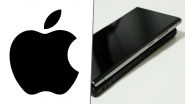Nottingham (UK), Sep 17 (The Conversation) As the new academic year gets underway, there is understandable concern over how to curb the spread of COVID in schools. Air-quality specialists in Australia have recommended that air purifiers with high-efficiency particulate air (Hepa) filters be installed in all classrooms.
The Welsh government, meanwhile, has set aside £6 million for air technologies - specifically, carbon dioxide sensors and ozone disinfection machines. Although, implementing ozone disinfection machines is currently on hold, pending evidence to support their use.
Also Read | Taliban Seize Truck Carrying Arms and Ammunition to Pakistan: Report.
This raises several questions. What are these different air cleaning technology options? What can they do that opening a window can't? And how important is ventilation in curbing the spread of COVID?
As indoor air quality experts, we have spent the last 18 months writing COVID ventilation and air cleaning tech guidance, and conducting research on the risk of catching COVID indoors.
We developed what's called a relative exposure index: a tool for comparing the risk of being exposed to the virus in different indoor settings. This was used by the UK government's scientific advisory group for emergencies (Sage) in drafting their ventilation advice for schools, workplaces and other public buildings.
New air cleaning technologies
Filtration systems, such as HEPA-grade air purifiers, have long been used indoors to deal with airborne dust and pollution. Research has demonstrated their effectiveness at removing small aerosols – solid and liquid particles suspended in the air – such as those from car exhausts, as well as removing respiratory aerosols breathed out by an infected person that may contain virus.
Another option being trialled, alongside Hepa filters, in schools in Bradford, is ultraviolet germicidal irradiation (UGVI). UGVI systems, which use UV light to destroy germs in the air, have been used for decades to reduce the transmission of diseases, particularly tuberculosis. However, they must be carefully installed and maintained to protect occupants from dangerous UV rays.
Not much research has been done on the use of standalone Hepa filters in real buildings to assess their capacity to reduce respiratory viral transmission, although there is good evidence that they can remove the aerosols in which viruses can be transported. However, they can be noisy and expensive. Crucially, there are no standard methods for testing their performance, and there is no guidance on maintenance.
A further option that has been floated is the use of ozone disinfection machines, to clean surfaces or the air. The problem here is that ozone is chemically active and reacts with all kinds of substances found in indoor spaces.
For example, ozone can react with the hydrocarbons in furnishings, or the natural oils left on surfaces by small and large hands, to produce chemicals that can be harmful to health, including formaldehyde. For this reason, Sage cautions against using these machines indoors.
There are other air cleaning technologies under consideration, but a wider question is: is air cleaning necessary to curb the spread of COVID? Or is adequate ventilation good enough?
COVID ventilation
Most people catch COVID from breathing in shared air. In the same way that you are more likely to smell what one might call coffee breath at close quarters, you are more likely to catch COVID by coming into direct contact with an infected person's exhaled air. This is because the virus is more concentrated in exhaled air than when breathing it in once it has been diluted by the air within a room.
The virus has in fact been modelled to be more than a thousand times more concentrated in exhaled puff than when fully mixed with air in a room. Ventilation and air cleaning technologies have little effect in removing virus in that exhaled puff. This is why social distancing is the best safeguard.
As engineers, we operate on the principle that it is impossible to achieve zero risk. Consequently, we try to reduce the highest risks for the greatest number of people. When increasing ventilation, there is a law of diminishing returns for the risk of COVID infection. Improving the air in poorly ventilated classrooms has a greater effect on risk than increasing ventilation in an adequately ventilated classroom.
Design guidance on ventilation and air quality for English school classrooms is better explained than for most other public spaces. We expect that classrooms that comply with these standards are adequately ventilated. Rooms that weren't specifically designed as classrooms or those where the ventilation design is not working correctly – for example, windows painted shut – are of greater concern. Air cleaning technologies are probably best suited to rooms where adequate ventilation can't be easily provided.
A carbon dioxide monitor can be used to identify poorly ventilated classrooms in some circumstances. And, if you don't have one, you can use your nose: if an occupied room smells bad when you enter, it needs more air.
A carbon dioxide sensor can also be a useful tool to let teachers and other school staff know when to open the windows, for example. Particularly in colder weather, this can help to balance the need for fresh air with warmth.
There are other happy consequences to be had with this push to ensure adequate ventilation in schools. It will reduce concentrations of indoor air contaminants, such as gases emitted by furnishings and water vapour, which, if left to build up, can be bad for your health. Further, ventilation has been shown to boost children's performance at school and contribute to keeping them healthy. (AP)
(The above story is verified and authored by Press Trust of India (PTI) staff. PTI, India’s premier news agency, employs more than 400 journalists and 500 stringers to cover almost every district and small town in India.. The views appearing in the above post do not reflect the opinions of LatestLY)












 Quickly
Quickly


